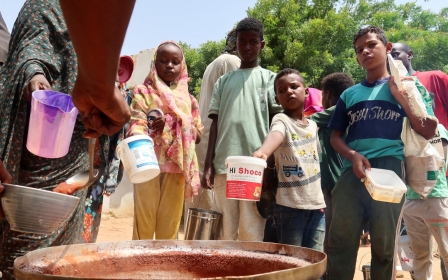Sudan: UN says 55,000 flee Sinja as RSF seizes 'strategic' city

The United Nations said on Monday that 55,000 people have fled southeasten Sudan's Sinja, as the paramilitary Rapid Support Forces (RSF) claimed it had taken the city from the Sudanese military.
The loss of Sinjar, the state capital of Sennar province, is a stinging blow to the Sudanese Armed Forces (SAF), who were routed last week as the RSF unexpectedly stormed the city of 250,000 people.
Already, the Sudanese conflict has displaced more than 10 million people. Since fighting broke out between the RSF and SAF in April 2023, around 150,000 people have been killed, according to US estimates.
The government's Humanitarian Aid Commission (HAC) in Gedaref said it expected up to 130,000 people to flee Sennar state in the coming days.
The World Food Programme said it has enough food in Gedaref to meet the needs of 50,000 people.
New MEE newsletter: Jerusalem Dispatch
Sign up to get the latest insights and analysis on Israel-Palestine, alongside Turkey Unpacked and other MEE newsletters
Many Sudanese fleeing Sinja are travelling towards the Blue Nile state capital of Damazin, according to AFP reports.
However, the UN says Damazin already hosts an estimated more than 600,000 displaced people who have fled fighting in Khartoum and other areas of the country.
Gedaref, meanwhile, also already hosts large numbers of refugees from neighbouring countries, Ethiopia and Eritrea, as well as internally displaced Sudanese.
The seizure of Sinja, which lies in a fertile region, has left Gedaref more vulnerable to RSF attack - a reality acknowledged by leaders in the city, who called a nighttime curfew after the Sennar state capital was overtaken.
The RSF advances in Sennar are likely to worsen Sudan's acute food security issues. Last week, UN experts accused SAF and the RSF of deliberately using starvation as a weapon of war.
A UN-backed report found that 25.6 million people, more than half of the population, face high levels of “acute food insecurity”, with 755,000 people in famine conditions and at risk of imminent death.
The RSF, led by Mohamed Hamdan Dagalo, better known as Hemeti, on Monday described its capture of Sinja as "crucial", saying the city was "strategic".
"The enemy suffered heavy casualties, numbering in the hundreds. Our troops have also taken control of all key institutions in the area, including the state government headquarters," it posted on X.
In other developments, the Halfaya Bridge, an important link between Khartoum North and Omdurman, was partially destroyed on 30 June, according to reports in the Sudan Tribune.
The bridge was the final remaining Nile crossing in the capital after the Shambat and Jebel Aulia Dam bridges were targeted in November last year.
Both the RSF and the Sudanese army blamed one another for the incident, the latest example of the war devestating Khartoum's infrastructure.
Middle East Eye delivers independent and unrivalled coverage and analysis of the Middle East, North Africa and beyond. To learn more about republishing this content and the associated fees, please fill out this form. More about MEE can be found here.





